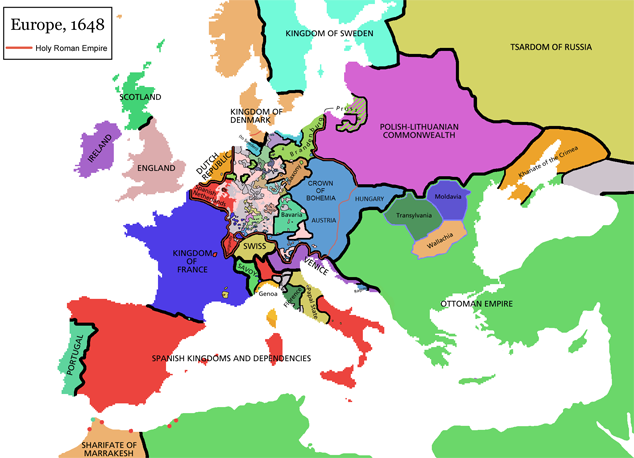Yesterday I wrote that “If Britain leaves the EU, the Nordic states (Sweden, Norway, and Finland) might follow”. Norway, of course, is not in the European Union at all. It can’t leave. It never joined.
Norway, Iceland, and Lichtenstein are members of the European Economic Area (EEA). They’re in the “single market” along with the 28 members of the European Union. Switzerland, steadfastly neutral (and well-armed) is not part of the EEA or the EU. Yet somehow it still manages to get by (mostly thanks to banking, watches, and chocolate).
Reversing the trend
But if it’s meaty thoughts you’re after, rather than pithy points, try this one for size: when we talk about the “disintegration of Europe” we’re talking about reversing a 368 year old trend. See the map below. It shows Europe in 1648, after the “Peace of Westphalia”.
Image licensed under CC BY-SA 3.0 via Commons.
Political authority has been centralising in Europe for almost 400 years. The Peace of Westphalia ended the 30-years war in the Holy Roman Empire. Germany didn’t even exist as a nation state. Nor did Italy. But with the Peace of Westphalia, borders began to harden in Europe.
Inside the new national walls, authority resided with the state (not the Church). It wasn’t exactly secular government or constitutional monarchy as we might recognise it today. But that was coming. And ever since then, the entire continent has moved toward “ever closer” political union and centralisation.
Just to be clear: I’m suggesting that a 400-year old trend may be reversing before your eyes. A truly diverse Europe is full of different languages, different cultures, different religions, and lots of walls. The Europe of the future, post Brexit, may be a lot more like the Europe of the past, at least in terms of political authority. Send your thoughts on the matter, clear or unclear, to dan@southbankresearch.com

Category: The End of Europe


